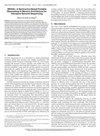以内存为中心的MCM-GPU架构
IF 1.4
3区 计算机科学
Q4 COMPUTER SCIENCE, HARDWARE & ARCHITECTURE
引用次数: 0
摘要
由于现代应用程序需要不断增加的计算能力和内存带宽,对强大gpu的需求持续增长。多芯片模块(MCM) GPU通过在中间层基板上集成GPU小芯片来提供可扩展性潜力,然而,它们受到以GPU为中心的设计的阻碍,即片外GPU带宽是静态地(在设计时)分配给本地而不是远程内存访问的。本文提出了以内存为中心的MCM-GPU架构。通过将HBM堆栈连接到中间层(而不是GPU)上,并将GPU连接到中间层网络上的网桥上,可以动态地将片外GPU的全部带宽分配给本地和远程内存访问。初步结果表明,与以gpu为中心的体系结构相比,以内存为中心的体系结构的性能平均提高了1.36倍(最高可达1.90倍)。本文章由计算机程序翻译,如有差异,请以英文原文为准。
Memory-Centric MCM-GPU Architecture
The demand for powerful GPUs continues to grow, driven by modern-day applications that require ever increasing computational power and memory bandwidth. Multi-Chip Module (MCM) GPUs provide the scalability potential by integrating GPU chiplets on an interposer substrate, however, they are hindered by their GPU-centric design, i.e., off-chip GPU bandwidth is statically (at design time) allocated to local versus remote memory accesses. This paper presents the memory-centric MCM-GPU architecture. By connecting the HBM stacks on the interposer, rather than the GPUs, and by connecting the GPUs to bridges on the interposer network, the full off-chip GPU bandwidth can be dynamically allocated to local and remote memory accesses. Preliminary results demonstrate the potential of the memory-centric architecture offering an average 1.36× (and up to 1.90×) performance improvement over a GPU-centric architecture.
求助全文
通过发布文献求助,成功后即可免费获取论文全文。
去求助
来源期刊

IEEE Computer Architecture Letters
COMPUTER SCIENCE, HARDWARE & ARCHITECTURE-
CiteScore
4.60
自引率
4.30%
发文量
29
期刊介绍:
IEEE Computer Architecture Letters is a rigorously peer-reviewed forum for publishing early, high-impact results in the areas of uni- and multiprocessor computer systems, computer architecture, microarchitecture, workload characterization, performance evaluation and simulation techniques, and power-aware computing. Submissions are welcomed on any topic in computer architecture, especially but not limited to: microprocessor and multiprocessor systems, microarchitecture and ILP processors, workload characterization, performance evaluation and simulation techniques, compiler-hardware and operating system-hardware interactions, interconnect architectures, memory and cache systems, power and thermal issues at the architecture level, I/O architectures and techniques, independent validation of previously published results, analysis of unsuccessful techniques, domain-specific processor architectures (e.g., embedded, graphics, network, etc.), real-time and high-availability architectures, reconfigurable systems.
 求助内容:
求助内容: 应助结果提醒方式:
应助结果提醒方式:


